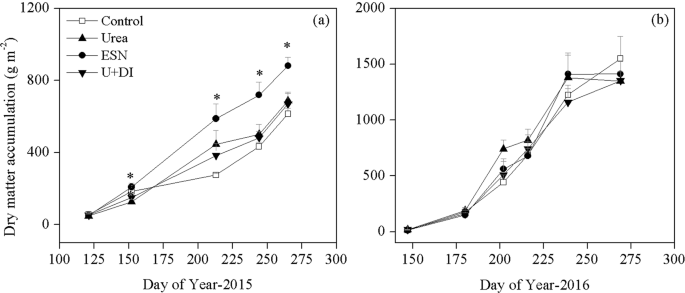
Delgado, J. A. Quantifying the loss mechanisms of nitrogen. J. Soil Water Conserv. 57, 389–398 (2002).
Glibert, P. M., Harrison, J., Heil, C. & Seitzinger, S. Escalating worldwide use of urea – a global change contributing to coastal Eutrophication. Biogeochemistry 77, 441–463 (2006).
Zaman, M. & Blennerhassett, J. Effects of the different rates of urease and nitrification inhibitors on gaseous emissions of ammonia and nitrous oxide, nitrate leaching and pasture production from urine patches in an intensive grazed pasture system. Agric. Ecosyst. Environ. 136, 236–246 (2010).
Norman, R. J. et al. Nitrogen fertilizer sources and timing before flooding dry-seeded, delayed-flood rice. Soil Sci. Soc. Am. J. 73, 2184–2190 (2009).
Rao, S. C. & Popham, T. W. Urea placement and nitrification inhibitor effects on growth and nitrogen accumulation by no-till winter wheat. Crop Sci. 39, 1115–1119 (1999).
Di, H. J. & Cameron, K. C. The use of a nitrification inhibitor, dicyandiamide (DCD), to decrease nitrate leaching and nitrous oxide emissions in a simulated grazed and irrigated grassland. Soil Use Manage. 18, 395–403 (2002).
Cambouris, A. N. et al. Potato response to nitrogen sources and rates in an irrigated sandy soil. Agron. J. 108, 391–401 (2016).
Zvomuya, F., Rosen, C. J., Russelle, M. P. & Gupta, S. C. Nitrate leaching and nitrogen recovery following application of polyolefin-coated urea to potato. J. Environ. Qual. 32, 480–489 (2003).
Malhi, S. S., Soon, Y. K., Grant, C. A., Lemke, R. & Lupwayi, N. Influence of controlled-release urea on seed yield and N concentration, and N use efficiency of small grain crops grown on dark gray luvisols. Can. J. Soil Sci. 90, 363–372 (2010).
Watts, D. B., Runion, G. B., Nannenga, K. W. S. & Torbert, H. A. Enhanced-efficiency fertilizer effects on cotton yield and quality in the Coastal Plains. Agron. J. 106, 745–452 (2014).
Gao, X. et al. Nitrogen fertilizer management practices to reduce N2O emissions from irrigated processing potato in Manitoba. Am. J. Potato Res. 94, 390–402 (2017).
Li, T. et al. Enhanced-efficiency fertilizers are not a panacea for resolving the nitrogen problem. Global Change Biol. 24, 511–521 (2018).
NBSC. National Bureau of Statistics of China. Available at, http://www.stats.gov.cn/tjsj/zxfb/201612/t20161220_1443527.html (2016).
Liu, T., Liang, Y. & Chu, G. Nitrapyrin addition mitigates nitrous oxide emissions and raises nitrogen use efficiency in plastic-film-mulched drip-fertigated cotton field. Plos One. 12, e0176305 (2017).
Guardia, G. et al. Effect of inhibitors and fertigation strategies on GHG emissions, NO fluxes and yield in irrigated maize. Field Crop Res. 204, 135–145 (2017).
Watts, D. B., Runion, G. B. & Balkcom, K. S. Nitrogen fertilizer sources and tillage effects on cotton growth, yield, and fiber quality in a coastal plain soil. Field Crop Res. 201, 184–191 (2017).
Yin, M., Gao, X., Tenuta, M., Gui, D. & Zeng, F. Presence of spring-thaw N2O emissions are not linked to functional gene abundance in a drip-fertigated cropped soil in arid northwestern China. Sci. Total. Environ. 695,133670 (2019).
Hou, Z., Li, P., Li, B., Gong, J. & Wang, Y. Effects of fertigation scheme on N uptake and N use efficiency in cotton. Plant Soil 290, 115–126 (2007).
Bazen, E. F., Larson, A. A. & Roberts, R. K. Economics of fertility management in cotton production in the United States. Dynam. Soil Dynam. Plant 1, 95–104 (2007).
Rowlings, D. W., Scheer, C., Liu, S. & Grace, P. R. Annual nitrogen dynamics and urea fertilizer recoveries from a dairy pasture using 15N: effect of nitrification inhibitor DMPP and reduced application rates. Agric. Ecosyst. Environ. 216, 216–225 (2016).
Wang, C., Isoda, A. & Wang, P. Growth and yield performance of some cotton cultivars in Xinjiang, China, an arid area with short growing period. J. Agron. Crop Sci. 190, 177–183 (2004).
Yeates, S. J., Constable, G. A. & McCumstie, T. Irrigated cotton in the tropical dry season. III: impact of temperature, cultivar and sowing date on fiber quality. Field Crop Res. 116, 300–307 (2010).
Cotton Incorporated. The Classification of Cotton. Available at, https://www.cottoninc.com/wp-content/uploads/2017/02/Classification-of-Cotton.pdf (2017).
Schleth, A. C., McAlister, D., Thibodeaux, D. & Riley, R. Current use of instrument technology in the cotton industry. Available at, https://wcrc.confex.com/wcrc/2007/techprogram/P1809.HTM (2007).
Mullins, G. L., Monks, C. D. & Delaney, D. Cotton response to source and timing of nitrogen fertilization on a sandy coastal plain soil. J. Plant Nutr. 26, 1345–1353 (2003).
Reiter, M. S., Reeves, D. W., Burmester, C. H. & Torbert, H. A. Cotton nitrogen management in a high-residue conservation system: cover crop fertilization. Soil Sci. Soc. Am. J. 72, 1321–1329 (2008).
Pettigrew, W. T. Environmental effects on cotton fiber carbohydrate concentration and quality. Crop Sci. 41, 1108–1113 (2001).
Zhao, W., Zhao, Z., Meng, Y., Chen, B. & Wang, Y. Modeling fiber fineness, maturity, and micronaire in cotton (Gossypium hirsutum L.). J. Intergr. Agr. 12, 67–79 (2013).
Haderlein, L., Jensen, T. L., Dowbenko, R. E. & Blaylock, A. D. Controlled release urea as a nitrogen source for spring wheat in western Canada: yield, grain N content, and N use efficiency. Sci. World J. 1, 114–121 (2001).
Zhou, L., Li, F., Jin, S. & Song, Y. How two ridges and the furrow mulched with plastic film affect soil water, soil temperature and yield of maize on the semiarid Loess Plateau of China. Field Crop Res. 113, 41–47 (2009).
Golden, B., Slaton, N., Norman, R., Gbur, E. & Wilson, C. Nitrogen release from environmentally smart nitrogen fertilizer as influenced by soil series, temperature, moisture, and incubation method. Commun. Soil Sci. Plan. 42, 1809–1824 (2011).
Kelliher, F. M., Clough, T. J., Clark, H., Rys, G. & Sedcole, J. R. The temperature dependence of dicyandiamide (DCD) degradation in soils: a data synthesis. Soil Biol. Biochem. 40, 1878–1882 (2008).
McGeough, K. L., Watson, C. J., Müller, C., Laughlin, R. J. & Chadwick, D. R. Evidence that the efficacy of the nitrification inhibitor dicyandiamide (DCD) is affected by soil properties in UK soils. Soil Biol. Biochem. 940, 222–232 (2016).
Yang, M., Fang, Y., Sun, D. & Shi, Y. Efficiency of two nitrification inhibitors (dicyandiamide and 3,4-dimethypyrazole phosphate) on soil nitrogen transformations and plant productivity: a meta-analysis. Sci. Rep. 6, 22075 (2016).
Ma, Z. et al. Urea fertigation sources affect nitrous oxide emission from a drip-fertigated cotton field in northwestern China. Agric. Ecosyst. Environ. 265, 22–30 (2018).
Gioacchini, P. et al. Influence of urease and nitrification inhibitors on N losses from soils fertilized with urea. Biol. Fert. Soils. 36, 129–135 (2002).
Carter, M. R. Soil sampling and methods of analysis. Boca Raton: Lewis Publ./CRC Press, https://doi.org/10.2134/jeq.2008.0018br (1993).
Source: Ecology - nature.com



